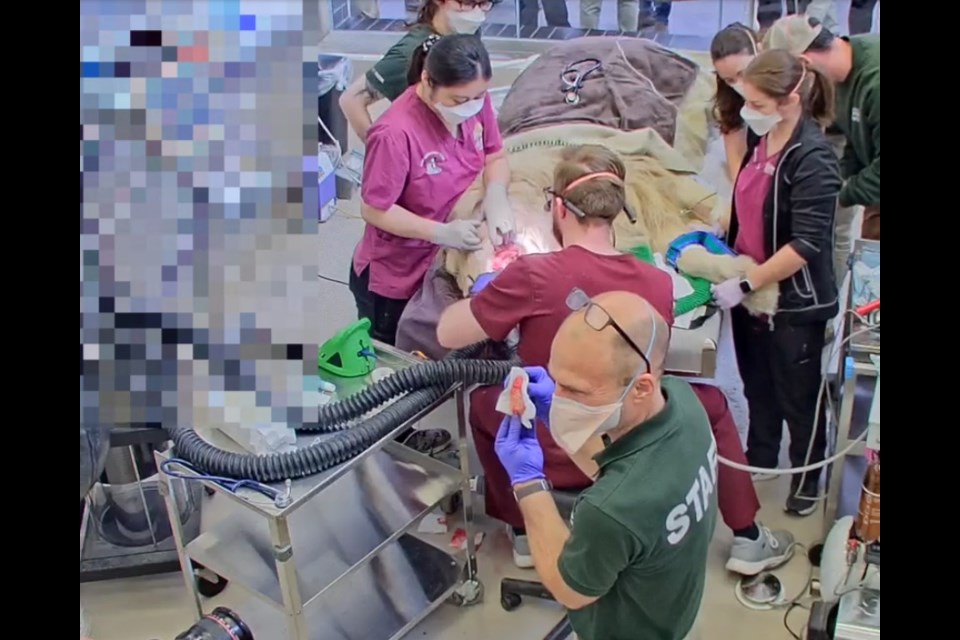It was definitely not the type of cat Guelph veterinarian Dr. Martin Hamilton was used to helping.
It was dental procedure day for one lion at the Toronto Zoo Thursday and Hamilton was in the lion's mouth to extract a tooth.
Fintan is the 12-year-old male white lion the dental surgery was performed on. He has lived at the Toronto Zoo since May of 2012, said Andrew Santos, strategic communications for the Toronto Zoo in an email.
Hamilton practices at the Hale Veterinary Clinic in Guelph. The clinic is a dental-only practice and his colleagues Kimberly Surette and Stella Zhu who are registered veterinary technicians assisted him in the surgery.
The procedure was performed at the Wildlife Health Centre at the Toronto Zoo. There was a live stream of the operating room hosted through Zoolife, an interactive look into zoos through its platform. The operation was three hours long.
“So the Toronto Zoo didn’t have anyone to perform dental services on their animals,” said Hamilton.
It’s quite a niche area, he said.
He said he believes the zoo reached out to multiple veterinarians to see who was interested “and we were one of them.”
Fintan had fractured his tooth a number of years ago and at the time someone at the zoo performed a root canal to save the tooth, Hamilton said.
“But root canal isn't always successful. And unfortunately for Fintan the root canal was not successful and his keepers had noted that he was uncomfortable on that side of his mouth,” said Hamilton.
It was his left upper canine tooth, he said.
X-rays were taken to confirm the root canal wasn’t successful. “And so we extracted the tooth so we could get rid of all the infection that was around the inside of the tooth,” he said.
Video clips taken from Toronto Zoo/Zoolife
Fintan does have some post-op instructions.
He’ll be on some anti-inflammatory medications and he will need to rest and heal from the extraction, said Hamilton.
“So it's a bit different than … a house cat. Because with the house cat we say feed soft food,” Hamilton said.
“I call it one of those cones of shame on which they can't really do with a huge lion or a tiger,” he said.
This was Hamilton’s first time performing dental surgery on a lion but just last month he operated on a tiger at the Toronto Zoo.
“Yeah … I kind of knew what to expect a little bit more. The tiger was definitely a learning opportunity. But also I’d done a lot of research beforehand. I talked to some people, some colleagues in the U.S. who have also done procedures on these big cats so they can give me a heads up of what to expect. So I could come up with a game plan beforehand and how I was going to approach things,” he said.
As Hamilton was performing Fintan’s surgery his team assisted with equipment and instruments he needed. They also helped hold Fintan’s lips since they needed to be pulled out of the way, Hamilton said.
The anesthesia to put Fintan under for the surgery was done by other people in the operating room.
“They've done it before. And so they know what drugs to give. Quite a daunting task. I had to put a lot of trust in them because if he wakes up that's not a good thing,” Hamilton said.
Tools like a dental bur similar to a drill, elevators, a tool used for extractions, scalpel blade, chisel and mallet were used in the surgery, he said.
An incision is made to the gum tissue so he can see the bone and the tooth. Some of the bone is removed to extract the tooth and tools are used to twist the tooth, Hamilton said.
“So I know after people get their wisdom teeth out they tend to leave the socket kind of open and you have to flush things out. But with lions and cats and dogs we can't really do that. So we have to then use that gum tissue that we lifted up to try and close the hole back over,” said Hamilton.
Fintan has some stitches that will dissolve in about a month, he said.
“I mean I'd like to highlight the importance of dental kind of diseases and treatments to animals whether they're cats and dogs or whether they're big cats that are at the zoo. It's important for all animals as well people,” said Hamilton.
